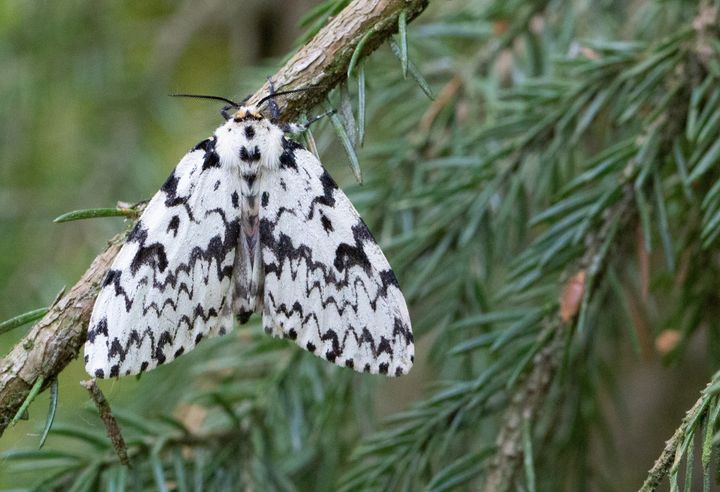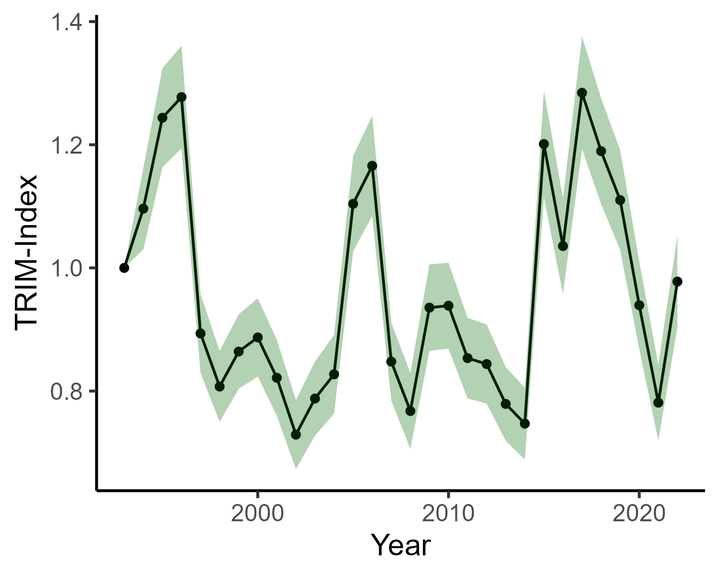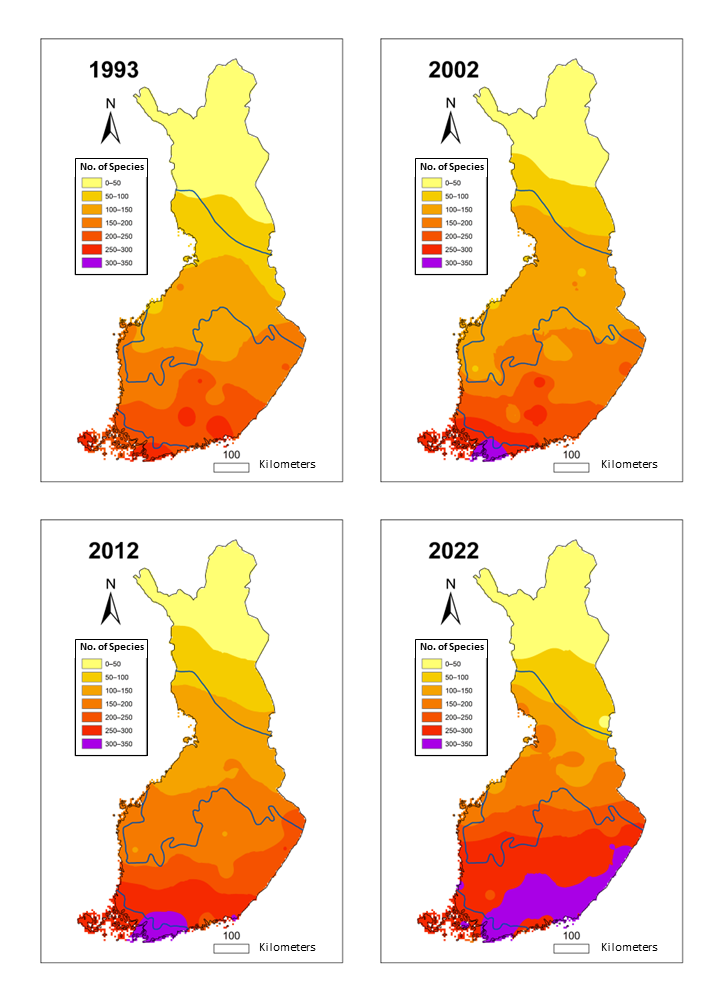Number of moths has remained stable for 30 years, but the species have changed significantly
The 30th anniversary report of the national Nocturna moth monitoring, coordinated by the Finnish Environment Institute (Syke) and launched in 1993, presents the history, background and changing species of moths in Finland. Nocturna is one of Finland's longest-running monitorings of species and the third longest-running moth monitoring in Europe. As moths are sensitive to changes in the environment, their monitoring provides valuable information about the effects of global warming, for example.

The emerging dominance of southern moth species
During the period of the national moth monitoring, several dozen new species of moths have spread into Finland. In addition, many species that were previously scarce and confined to the south of the country have spread strongly northwards, resulting in a more "southern" composition of moth communities, especially in the southern half of the country. At the same time, many species that have adapted to the cool climate found in Finland have moved further north and even disappeared from more southerly areas.
“Such changes are expected to continue in the future as the climate warms,” says Juha Pöyry, Senior Researcher at Syke.
Overall, the number of moth species detected annually at monitoring sites has increased over the past 30 years. Many species have also seen strong increases in numbers, but an equal number of species have declined. A strong annual variation in the total number of individuals has been observed, and throughout the monitoring period the abundance of moths has been found to fluctuate on a cycle of about 10 years. Despite the fluctuations, there has been no clear upward or downward trend in the total number of individuals.


Moth monitoring provides valuable information
In addition to global warming, the most likely environmental causes of changes in moth populations include land use changes, such as logging and intensified farming, which may have degraded habitats for some species. Nitrogen deposition through food chains and reduced air pollution may also have contributed to the changes. For example, moth species that feed on lichens are likely to have benefited from the reduction in acid deposition and the increase in nitrogen content of lichens.
The effects of warming temperatures and a longer growing season are also reflected in the increasing number of moths that are multivoltine, with more and more species producing a second generation in late summer or autumn.
Living in a wide range of diverse habitats, moths react to and are sensitive to changes in their environment.
“It would be important to continue monitoring moths in the future, so that we have up-to-date information on the effects of these changes," says Ida-Maria Huikkonen, a researcher at SYKE.
Moth monitoring time series one of the longest in Europe
The Nocturna moth monitoring started in 1993 as a general survey covering a wide range of habitats, but in the late 1990s it focused mainly on monitoring moth species in forest habitats. Nocturna is one of Finland's longest-running surveys of species and the third longest-running moth survey in Europe.
Monitoring has been carried out using light traps: the traditional Jalas moth traps were initially used, but in 2020 a new type of freezer trap was introduced. Originally, the regional ELY centres were responsible for the maintenance of the traps, but nowadays this is largely done on a voluntary basis.
The accumulation of high-quality data has been made possible throughout the monitoring activities by moth enthusiasts who have acted as volunteer data analysts.
“There’s a long tradition of butterfly and moth hobbyists and research in Finland, and there have been plenty of enthusiastic moth observers over the years”, says Huikkonen.
The long, geographically comprehensive time series is extremely valuable and has been widely used in scientific studies. The data has been used to study species distributions and their links to environmental changes, such as climate change, and interactions between different groups of organisms.
Keywords
Contacts
Researcher Ida-Maria Huikkonen, firstname.lastname@syke.fi, p. 0295 252 255
Senior Researcher Juha Pöyry, firstname.lastname@syke.fi, p. 0295 251534
Media service at Finnish Environment Institute
Our Media Service provides information on research, helps journalists find experts for interviews and provides photos for media use.
Our Communication experts will answer your inquiries on weekdays from 9 am to 4 pm.
Links
Finnish Environment Institute - We build hope through research.
Finnish Environment Institute
Latokartanonkaari 11
00790 Helsinki
+358 295 251 000
It is time to move beyond solving environmental problems one by one, to systemic sustainability transformations. The Finnish Environment Institute (Syke) contributes to building a sustainable society through research, information and services. The Finnish Environment Institute is a research institute with 700 experts and researchers located in Helsinki, Oulu, Jyväskylä and Joensuu.

Subscribe to releases from Suomen ympäristökeskus
Subscribe to all the latest releases from Suomen ympäristökeskus by registering your e-mail address below. You can unsubscribe at any time.
Latest releases from Suomen ympäristökeskus
Nuoret vaativat merkittäviä muutoksia ruuan kulutukseen ja tuotantoon16.12.2025 12:00:00 EET | Tiedote
Nuorten ruokaraati vaatii avointa ja tutkittua tietoa ruuasta – sen alkuperästä, tuotantotavoista ja vaikutuksista ilmastoon, luontoon ja hyvinvointiin. Ilman selkeitä faktoja vastuulliset kulutusvalinnat eivät ole mahdollisia. Nuoret luovuttavat kannanottonsa kansalliseen ruokastrategiaan 2040 maa- ja metsätalousministeriön tilaisuudessa 16.12.2025.
Kommunernas utsläpp fortsätter minska – trafikens andel av utsläppen ökar16.12.2025 06:00:00 EET | Pressmeddelande
Enligt förhandsberäkningsuppgifterna för 2024 minskade Finlands växthusgasutsläpp enligt Hinku-beräkningsreglerna med cirka fem procent jämfört med föregående år. På lång sikt har utsläppen sedan år 2005 minskat med 40 procent och jämfört med år 1990 med 43 procent.
Kuntien päästöt laskevat edelleen – liikenteen osuus päästöistä kasvaa16.12.2025 06:00:00 EET | Tiedote
Vuoden 2024 ennakkolaskentatietojen perusteella Hinku-laskentasääntöjen mukaiset Suomen kasvihuonekaasupäästöt laskivat noin viisi prosenttia edelliseen vuoteen verrattuna. Pitkällä aikavälillä vuodesta 2005 lähtien päästöt ovat vähentyneet 40 prosenttia ja vuoteen 1990 verrattuna 43 prosenttia.
Viikkokatsaus 15.–19.12.202511.12.2025 12:59:58 EET | Tiedote
Hei! Tässä tiedoksesi meillä Suomen ympäristökeskuksessa ensi viikolla ilmestyviä tiedotteita, uutisia, kampanjoita, blogeja ja uutiskirjeitä. Mukana myös tulevia tapahtumia ja webinaareja. Jakelemme viikkokatsauksen torstaisin STT:n kautta. Koosteet löytyvät myös STT-uutishuoneesta, josta voit tilata kaikki Suomen ympäristökeskuksen tiedotteet.
Viikkokatsaus 8.–12.12.20254.12.2025 12:30:18 EET | Tiedote
Hei! Tässä tiedoksesi meillä Suomen ympäristökeskuksessa ensi viikolla ilmestyviä tiedotteita, uutisia, kampanjoita, blogeja ja uutiskirjeitä. Mukana myös tulevia tapahtumia ja webinaareja. Jakelemme viikkokatsauksen torstaisin STT:n kautta. Koosteet löytyvät myös STT-uutishuoneesta, josta voit tilata kaikki Suomen ympäristökeskuksen tiedotteet.
In our pressroom you can read all our latest releases, find our press contacts, images, documents and other relevant information about us.
Visit our pressroom